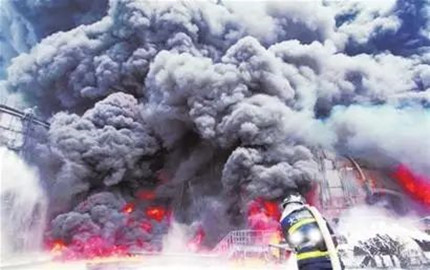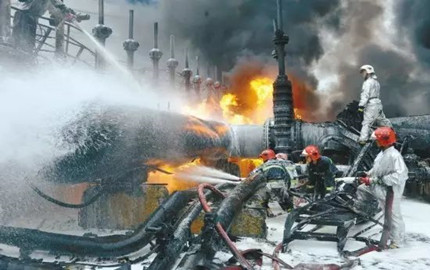Knowledge Technology of Pressure pipeline
Knowledge Technology of Pressure pipeline
Stepping into the industrial zone, you will find pressure pipes everywhere, and some even smoking. This is what I fear most, and I always feel that it will explode at any time.
But this is the fact. Maybe it will really explode. This is not an alarmist talk. You will understand if you follow the editor and look at a few pictures.


These are all tragedies caused by normal operations or improper daily inspections!
Therefore, it is very important to master the daily inspection items of pressure pipelines and preventive measures for pressure pipeline accidents!
Pressure pipeline characteristics
The so-called pressure pipeline refers to the use of pressure to transport gas, liquid, etc.
But not all pipelines can be called pressure pipelines.
Two conditions:
1. Pressure>=0.1Mpa (gauge pressure)
2. Pipe DN>=25mm
Features
1. The pressure pipeline is a system that affects the whole body.
2. The pipe has a large length-to-diameter ratio, which is easy to lose stability, and the stress condition is more complicated than that of a pressure vessel.
3. The fluid flow in the pipeline is complex, the buffer space is small, and the frequency of working conditions is higher than that of the pressure vessel (such as high temperature, high pressure, low temperature, low pressure, displacement deformation, wind, snow, earthquake, etc.) .
4. There are many types of pipeline components and pipeline supports, each material has its own characteristics and specific technical requirements, and the selection of materials is complicated.
5. There are more possible leak points on the pipeline than on the pressure vessel, and there are usually five points on only one valve.
6. There are many types and large quantities of pressure pipelines, and there are many links in design, manufacturing, installation, inspection, and application management, which are very different from pressure vessels.
Daily inspection and maintenance items of pressure pipeline
Pressure pipeline preventive measures
The following pressure pipelines should be equipped with safety valves
1. A safety valve should be installed on the outlet pipeline of positive displacement pumps such as electric reciprocating pumps and gear pumps. The vent pipe of the safety valve should be connected to the pump inlet pipe, and an accident stop interlock device should be installed (except for the equipment itself with a safety valve);
2. A safety valve should be installed at the outlet of each section of the combustible gas reciprocating compressor, and the vent pipe of the safety valve should be connected to the inlet pipe of each section of the compressor or the inlet pipe of the compressor section;
3. Pipelines where the combustible gas and combustible liquid may expand beyond the design pressure when heated should be equipped with safety valves;
4. On the liquefied hydrocarbon pipelines that may be closed at both ends, which may cause pressure increase, safety valves or other safety measures should be installed;
5. When the equipment connected to the outlet of the blower, centrifugal compressor, centrifugal pump or steam reciprocating pump cannot withstand its maximum pressure, the outlet pipeline of the above-mentioned pump shall be equipped with a safety valve.
Pipe electrostatic grounding
1. In pipelines that transport flammable and explosive liquids or gases, the flow of materials along the pipeline and the process of entering and exiting containers from the pipeline will generate static electricity. The accumulation of a certain amount of electrostatic charge will cause electrostatic failure and electrostatic disaster.
2. Especially for high-temperature, high-pressure, inflammable, explosive, toxic and harmful chemical equipment, ensuring the safety of static electricity, preventing static electricity failures, static electricity disasters, is a condition for maintaining normal production order.
3. The metal parts of the non-conductor pipe section must be grounded, especially the metal joints in the middle must be grounded to prevent static electricity accumulation and electrostatic discharge.
Choose the right material
1. Strictly conduct non-destructive inspections of material defects, especially castings, forgings and high-pressure pipelines. If defective materials are found, they shall not be put into use.
2. After installation, perform a hydraulic test. The test pressure should be 1.5 times the working pressure.
3. Choose the steel pipe form and material correctly according to the process conditions of the pipeline, and it must not be replaced or misused at will.
4. Perform visual inspection and non-destructive inspection on the welds of the pipeline to ensure welding quality.
Stepping into the industrial zone, you will find pressure pipes everywhere, and some even smoking. This is what I fear most, and I always feel that it will explode at any time.
But this is the fact. Maybe it will really explode. This is not an alarmist talk. You will understand if you follow the editor and look at a few pictures.


These are all tragedies caused by normal operations or improper daily inspections!
Therefore, it is very important to master the daily inspection items of pressure pipelines and preventive measures for pressure pipeline accidents!
Pressure pipeline characteristics
The so-called pressure pipeline refers to the use of pressure to transport gas, liquid, etc.
But not all pipelines can be called pressure pipelines.
Two conditions:
1. Pressure>=0.1Mpa (gauge pressure)
2. Pipe DN>=25mm
Features
1. The pressure pipeline is a system that affects the whole body.
2. The pipe has a large length-to-diameter ratio, which is easy to lose stability, and the stress condition is more complicated than that of a pressure vessel.
3. The fluid flow in the pipeline is complex, the buffer space is small, and the frequency of working conditions is higher than that of the pressure vessel (such as high temperature, high pressure, low temperature, low pressure, displacement deformation, wind, snow, earthquake, etc.) .
4. There are many types of pipeline components and pipeline supports, each material has its own characteristics and specific technical requirements, and the selection of materials is complicated.
5. There are more possible leak points on the pipeline than on the pressure vessel, and there are usually five points on only one valve.
6. There are many types and large quantities of pressure pipelines, and there are many links in design, manufacturing, installation, inspection, and application management, which are very different from pressure vessels.
Daily inspection and maintenance items of pressure pipeline
| Check item | Check content | The harm of the problem | Maintenance methods and measures |
| Pressure gauge |
1. Whether the surface glass is broken; 2. Whether the indication is sensitive; 3. Whether the pressure guiding tube is unblocked; 4. Whether the lead seal is intact. |
Incorrect instructions may cause overpressure. | Regular inspection and maintenance. |
| Galvanic thermometer | Whether the temperature indication is accurate. | Over-temperature will cause stress corrosion and creep of pipeline materials. | Regular check and maintenance. |
| Safety valve |
1. Whether there is any foreign matter stuck in the middle of the spool spring; 2. Whether the adjustment screws are loose; 3. Whether the spring and other parts are damaged or leaking; 4. Whether the lead seal is intact; 5. Whether the lead seal of the isolation valve is intact. |
1. Air leakage; 2. Pipeline accidents caused by the failure of the safety valve to take off during overpressure. |
Perform verification when stopping or depressurizing. |
| Rupture disc |
1. Whether the diaphragm has defects; 2. Whether the catheter is unblocked. |
Cause a pipeline accident. |
1. Pay attention to the inspection before installation; 2. Regular replacement as required. |
| Pipe support |
1. Whether the bracket is loose; 2. Whether the pipeline vibrates; 3. Whether the bracket is damaged. |
1. The pipeline is broken due to wear and fatigue; 2. The pipeline stress increases. |
Tighten the bolts or reinforce. |
| Pipe rack foundation |
1. Whether the foundation sinks; 2. Whether the foundation is cracked. |
Damage to the foundation causes additional stress on the pipeline, threatening safe production. |
1. Regularly observe the subsidence of the foundation and take targeted measures; 2. Determine whether the crack continues to expand. |
| Insulation |
1. Whether the main material is damaged, dropped, damp, or failed; 2. Whether the moisture barrier is damaged; 3. Whether the outer protective layer is damaged or peeled off. |
1. Generate heat loss in the pipeline; 2. Corrosion; 3. The insulation structure loses its protection and is destroyed prematurely. |
1. Replace insulation materials; 2. The damage should be repaired in time. |
| Bolt |
1. Whether it is corroded; 2. Is it loose? |
1. Corrosion of the screw and thread; 2. Cause a leak. |
1. Apply anti-rust oil; 2. Tighten the bolts. |
Pressure pipeline preventive measures
The following pressure pipelines should be equipped with safety valves
1. A safety valve should be installed on the outlet pipeline of positive displacement pumps such as electric reciprocating pumps and gear pumps. The vent pipe of the safety valve should be connected to the pump inlet pipe, and an accident stop interlock device should be installed (except for the equipment itself with a safety valve);
2. A safety valve should be installed at the outlet of each section of the combustible gas reciprocating compressor, and the vent pipe of the safety valve should be connected to the inlet pipe of each section of the compressor or the inlet pipe of the compressor section;
3. Pipelines where the combustible gas and combustible liquid may expand beyond the design pressure when heated should be equipped with safety valves;
4. On the liquefied hydrocarbon pipelines that may be closed at both ends, which may cause pressure increase, safety valves or other safety measures should be installed;
5. When the equipment connected to the outlet of the blower, centrifugal compressor, centrifugal pump or steam reciprocating pump cannot withstand its maximum pressure, the outlet pipeline of the above-mentioned pump shall be equipped with a safety valve.
Pipe electrostatic grounding
1. In pipelines that transport flammable and explosive liquids or gases, the flow of materials along the pipeline and the process of entering and exiting containers from the pipeline will generate static electricity. The accumulation of a certain amount of electrostatic charge will cause electrostatic failure and electrostatic disaster.
2. Especially for high-temperature, high-pressure, inflammable, explosive, toxic and harmful chemical equipment, ensuring the safety of static electricity, preventing static electricity failures, static electricity disasters, is a condition for maintaining normal production order.
3. The metal parts of the non-conductor pipe section must be grounded, especially the metal joints in the middle must be grounded to prevent static electricity accumulation and electrostatic discharge.
Choose the right material
1. Strictly conduct non-destructive inspections of material defects, especially castings, forgings and high-pressure pipelines. If defective materials are found, they shall not be put into use.
2. After installation, perform a hydraulic test. The test pressure should be 1.5 times the working pressure.
3. Choose the steel pipe form and material correctly according to the process conditions of the pipeline, and it must not be replaced or misused at will.
4. Perform visual inspection and non-destructive inspection on the welds of the pipeline to ensure welding quality.




